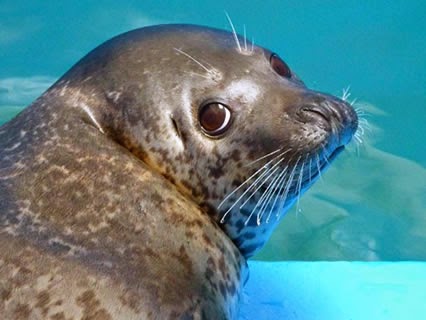Reading Activities Complying Seven Reading Comprehension Strategies 1
The followings are the reading activities we decided complying 7 reading comprehension strategies to promote the reading and understanding of Roald Dahl's The Enormous Crocodile.
1. Activating
or building background knowledge
Ask questions and
show pictures of animals in order to activate students’ background knowledge of
animals. Students may think about the characters of different kinds of animals.
For example, lion and tigers are big and fierce and they live in the
forest/jungle. Crocodiles are big and live in waterside of the jungle.
Ask the following
questions and let students know different kinds of animals.
1.
Have
you ever been to the Hong Kong Ocean Park?
(Show some pictures of the Ocean Park to
students)
2.
What
animals can you see in the Ocean Park?
Pandas, dolphins, alligators/crocodiles (similar
animals), sealions, seals, fox, monkey
Panda
dolphins
the
cuddly red pandas
Arctic
Fox Den
Snowy owl
spotted
seals
monkey
1.
Have
you ever been to the forest/jungle?
2. What can you see in the forest/jungle?
Hippopotamus
Monkey

crocodile
3.
What
animals do you like? Why?
4.
What
animal are you afraid of? Why?
5.
Have you
been ever tricked by an animal/a bird?
6.
Did it
hurt you? How were you feeling?
t
2. Using sensory images
a.
Using
pictures to make students know more about crocodiles and their characteristics
b.
Using
pictures Introduce the main character: the Enormous Crocodile and the other
character
(i)
Ask students
to look at the big picture of the Enormous Crocodile




1.
Look at
the picture of the Enormous Crocodile and describe the Enormous Crocodile.
Ask students to
describe the Enormous Crocodile
-
Streamline
body
-
Long and big jaw
-
Sharp and strong teeth
-
Webbed
feet
(They have a streamlined body that enables them to
swim swiftly. Crocodiles also tuck their feet to their sides while swimming,
which make them faster by
decreasing water resistance. They have webbed feet which, although not
used to propel the animal through the water, allow it to make fast turns
and sudden moves in the water or initiate swimming. Webbed feet are an
advantage in shallower water where the animals sometimes move around by
walking. Crocodiles are ambush hunters, waiting for fish or land animals to come
close, and then rushing out to attack.)
decreasing water resistance. They have webbed feet which, although not
used to propel the animal through the water, allow it to make fast turns
and sudden moves in the water or initiate swimming. Webbed feet are an
advantage in shallower water where the animals sometimes move around by
walking. Crocodiles are ambush hunters, waiting for fish or land animals to come
close, and then rushing out to attack.)
2.
What do
you think the Enormous Crocodile like to eat??
Fish, frogs, birds, crabs, reptiles,
insects
3.
Where did
the Enormous Crocodile live?
River side of the jungle
4.
If you
were the Enormous Crocodile, what do you want for your meals?
(ii)
Show
pictures of the other pictures and ask students some questions
Muggle-Wump Monkey
Trunky the Elephant
Roly-Poly Bird
(iii)
Show
the picture and ask questions-let students to understand in the story
Look at the picture and answer the questions.
1.
Where
was it?
2.
Who
were in the place?
3.
What
trick did the Enormous Crocodile play in the picture?
4.
What
did the Enormous Crocodile look like?
5.
Why did
the Enormous Crocodile make himself look like such thing in the picture?
7.
What
did the children do after know that it was not a real seesaw?
8.
If you
were one of the children, what would you do?
3. Questioning
Ask
questions related to the story and make students understand the story
(i)
Read Page 1to 8 and answer the following questions
1.
What did the enormous crocodile want for his lunch?
A.
Fish B.
Humpy-Rumpy
C.
Children D. Trunky
2. How many animal(s) did the Enormous Crocodile
meet in the jungle?
A. 1 B. 2
C. 4 D. 5
(ii)
Read
Page 9-13, answer the following questions
1.
In the
Clever Trick Number One, who
did the Enormous Crocodile meet?
A. Toto & Mary B. Sam & Kate
C. Alex & Sally D. Tom & Bobo
2. What did the Enormous Crocodile in ‘Clever Trick Number One’?
A. a seesaw B.
a coconut tree
C. a wooden crocodile on a
merry-go-around D. a bench
3.
Who helped the children?
A.
Roly- Poly Bird B. Humpy-Rumpy the Hippopotamus
C.
Muggle-Wump Monkey D.
Trunky the Elephant
(iii)
Read
the story and answer the following questions.
1.
How
many tricks did the Enormous
Crocodile play in the story?
Four tricks
2. What
did the Enormous Crocodile pretend in ‘Clever Trick Number One’?
a coconut tree
3. What
did the Enormous Crocodile
pretend ‘Clever Trick Number Two’?
a seesaw
4. What
did Trunky do to the Enormous Crocodile at last?
Swing and throw the Enormous Crocodile up into the
sky
7: Synthesizing
1. Information +
Response = Synthesis
a. Did The Enormous Crocodile
change the way you feel about nature, or about wilderness?
b. What if the Enormous Crocodile
had gone to Hong Kong? Would it have had to eat the children in different ways?
c. What do you think would have happened if The Enormous Crocodile had not told the clever tricks to other
animals? Would it be the same result that it became under the book's
circumstances?
2. Information + Interpretation = Synthesis
Readercan gaining new insights (wisdom) about life:
Citation from the book:
“I have a secret plans and clever tricks”
Synthetic thinking:
When you tell a secret plans and clever tricks to someone you trusted.
But finally they betray you .
Have you experienced a similar situation sometimes?















No comments:
Post a Comment